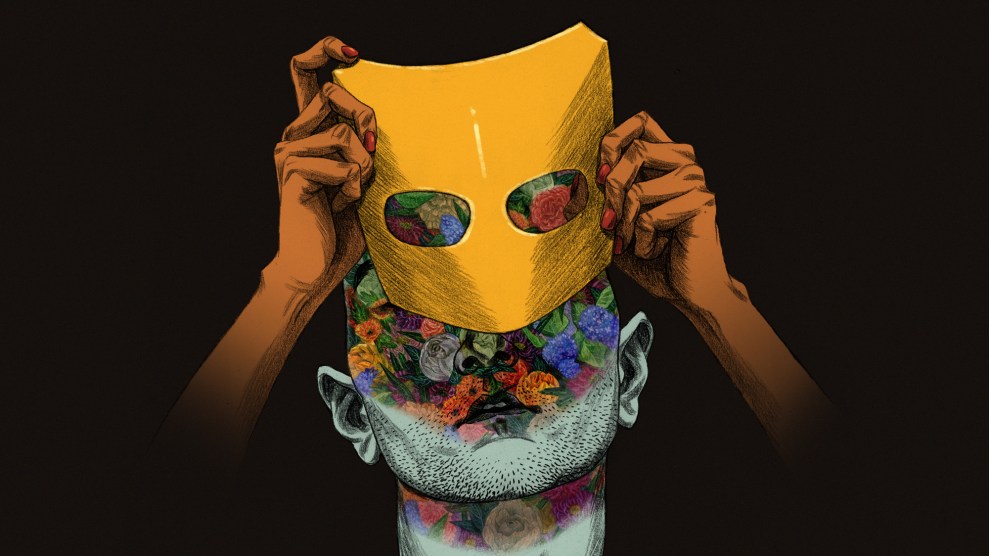
Emeric L. Kennard
Not long ago, I was a gay boy, and like most gay boys, I met my lovers through Grindr. On the infamous queer dating app, which displays a grid of nearby users’ photos sorted by distance, I was initiated into the gay cult of masculinity and learned that misogyny thrives even in the absence of women. Many guys’ profiles said they were “masc4masc,” or plainly barked “no fems.”
It was just like in the clubs, where dudes in bro-tanks and snapbacks flirted with other dudes in bro-tanks and snapbacks, nervously edging away from the swishy, squealing, feminine gays with whom they shared the dance floor. Masculinity was king, and manhood was our bulwark against embarrassment: We might be faggots, but at least we aren’t girls.
I shaped myself according to the messages I internalized, doing crunches in the gym and posing with a butch face to win the attention of big-biceped men, and they played their roles in turn, treating me with bullish impatience and demanding nudes in caveman English.
Eventually, I realized this wasn’t for me: I’m more of a girl than a boy. I discovered this as I gradually gained the courage to liberate my feminine instincts, which had been buried so long I forgot where I’d put them. Women—both trans and cis—taught me to honor softness and my emotional depths, which boys had long degraded. As I grew my hair long and painted my nails, I became increasingly invisible to the gay men on Grindr. But I now attracted a separate crop of suitors, from a lesser-known stratum of the app: the hordes of straight, bi, and pansexual men who use Grindr to meet trans girls.
These boys hewed to a different cultural script. They tried to charm me with pickup lines and offered to take me on dates. They told me I was pretty and called me “babe” or “goddess.” After a long day of getting misgendered in public, I found great validation in turning on my phone to finally be treated like a lady. Of course, that often meant being treated like shit.
After a few minutes of their superficial charms, these guys also wanted nudes. Many of them catfished me, using fake profiles as bait for my pics, or beguiled me with chats that vanished in the morning, when I’d discover that my dream boy had blocked me. While closed-minded gay men degraded my femininity, these other boys prized it. The more I looked like a woman to them, the more they hit me up. But far from freeing me from the scourge of misogyny, transitioning merely brought me to its latest frontier: As a trans femme, I was a special kind of sex object, a novel fantasy that drives boys wild, but that they feel ashamed to desire.
“Whenever I log on, I get notified that several people in my inbox have deleted their profile, which I believe is only really common for [trans women],” says Charlene Incarnate, a prominent trans drag performer in Brooklyn. She too gets bombarded with Grindr messages from men who are intrigued or explicitly turned on by the fact that she has a dick. Grindr gives men a “more secure way of cruising us,” says Charlene. “All of my non-queer-identified sex partners [come] from Grindr.” But dating those men means navigating the quagmire of their fears and insecurities. They’re “still getting lost in their own hang-ups.”
While originally launched as a gay dating app, Grindr now includes “trans and queer people” in its marketing language, and photos of trans femmes in its ads. A Grindr spokesperson told me that trans people are “integral” to the platform, which in 2018 added profile fields allowing users to display their gender identities and pronouns. A spokesperson for Scruff, a similar app, says that roughly 5 percent of its users are either trans-identified or looking for trans people. Based on the composition of my local grid, I’d venture to say that Grindr’s rate is much higher. As a result, more and more straight and bisexual men are using gay apps to find trans girls like Charlene and me.
My encounters with these men are mottled by shame, a reticence I can’t imagine they also show to cis girls. When chatting with me, they withhold their real names, or Snapchat me from burner accounts, not the ones they use with their friends. Their promises of dates are often achingly hollow. After texting me for weeks, they end up too afraid to meet. They ghost without a word of explanation. Anyone who’s tried to date during the pandemic will have gotten a taste of what it’s like to date as a trans woman—it’s textual, two-dimensional, full of lurching conversation and unwanted dicks.
A version of this article originally ran online last year, and after reading it, a college boy in my area (I’ll call him Nate) messaged me on Grindr. Nate admitted that he engaged in the behaviors I disparaged, like blocking trans girls instead of saying goodbye when he felt shame well up. He now saw the error of his ways, he said, and was eager to liberate his sexuality from labels. But when I asked for his number, he suggested we talk on Snapchat—an app where the messages disappear—and he gave me a handle that was different from the one he used to keep up with his friends (and his cis girl crushes, I imagine).
Though he was young, I found myself texting Nate a lot. He was cute and smart; we both liked Russian literature; and unlike most guys from Grindr, he at least said he wanted to do better. Nate suggested we go running together, a rare invitation to a date rather than a hookup. But when the evening we agreed on came around, I sent him a text to firm up plans and didn’t hear back.
Late the next day, I got a text from Nate. “Sorry,” it said. “I was feeling sick and a bit nervous. Hope you’ll give me another chance.” I wanted nothing more than to scold him, but feeling as if I wouldn’t find another boy like him, I quashed the impulse and said we could try again next week. Somehow, that was the end of my courtship with Nate. He ghosted me like all the others had.
To better understand what’s going through the heads of boys like Nate, I spoke with Perry Gruber, who counsels trans-attracted men through his program, the Transamorous Network. Gruber says the men he works with are often insecure about whether their attraction to trans women is “wholesome and legitimate.” If they “subscribe to the flawed premise” that everyone with a penis is a man, they might wonder if loving trans women makes them gay or view it as “a perversion to be exorcised.” These men are stigmatized not only by society, Gruber says, but also by the trans women they seek. Many of us are quick to write them off as “chasers,” a term that implies they are exploitative harassers who fetishize trans bodies.
The Transamorous Network aims to help men rise above “chaser” behaviors to become “transamorous,” a word Gruber defines as suiting someone who is “out and proud about their trans attraction” and treats their lover “as a whole human being.” TJ Billard, the University of Southern California researcher behind one of very few studies on trans-attracted men, observed a “significant” amount of shame in those he surveyed. “It’s an external shame specifically,” he tells me. “Shame about not wanting people in their lives to know that they have these desires.”
Gruber, who identifies as transamorous, agrees with me when I suggest that not many trans-attracted men treat their partners as whole human beings. For many of them, meeting a trans girl in person is a big step. “Most of the guys we’ve talked with get their ongoing awareness of trans women from porn.”
This doesn’t surprise me. It’s consistent with the work of trans journalist Diana Tourjée, who for years has documented the experiences of trans-attracted men. “I first realized I was interested in trans women when I watched trans porn as a teenager,” says Jeremy, a 20-year-old she interviewed recently. Many of her subjects tell similar stories.
The popularity of trans porn has been rising for years. Data shared by PornHub, one of the most popular porn sites, reveals that searches for trans content tripled between 2014 and 2017; it now ranks among the top 10 categories in many parts of the world. Trans porn is especially popular among men, whose searches for the term climbed another 167 percent in 2018.
PornHub’s data is regularly used by scholars at universities worldwide. Sophie Pezzutto, a researcher at the Australian National University, is conducting the first ethnography of the trans porn industry, which has brought her into contact with the genre’s consumers. Porn is often the first place they see “a trans person being portrayed in a sexual and attractive way,” she says. “There certainly are a number of trans porn fans who have been watching trans porn for years and eventually seek sexual encounters with trans people.”
The rise of the genre might suggest a growing embrace of trans attraction. Billard’s study found a small but significant association between trans porn viewership and positive attitudes toward trans people. Yet on porn sites, the “Trans” genre is sometimes listed under “Fetish,” alongside “Bondage” and “Toys,” and tends to be labeled with crass slurs like “tranny” or “shemale.” As long as people’s interactions with trans folk are confined to this hypersexualized, degrading space, their relations with us will be shaped accordingly.
It makes sense that boys on apps are content to interact with me virtually: The context is familiar to them, and if they don’t meet me in the flesh, there’s less impetus to treat me like a person, rather than a thing that will scratch the surface of their fantasy and then disappear when convenient—until they’re horny again. Since the coronavirus hit, I’ve gotten several texts from numbers not saved in my phonebook. “Been a while,” someone messaged me just the other morning. When I asked who it was, he quickly replied, “It’s Dalton,” then sent me a photo of his dick.
I have no idea who Dalton is. He probably ghosted me long ago, given that I’d deleted our chat history. But the thrill of chasing a trans girl had him scrolling back through months of threads to find me again, in the midst of a global pandemic. I’d be flattered if it weren’t so clear that he saw me as just some flat object on his phone, available on demand.
“I have a theory about fetishes,” says writer Juno Dawson in her gorgeous essay in the Guardian about dating while trans. “If society has no issue with your tastes (tall men, big boobs, leggy, beards, tattoos), it is a ‘type.’ However, if you are into something society frowns upon (plus-size people, trans people, leather, rubber, watersports), it is a ‘fetish.’” She writes that many of the men who contact her on apps are longing to satisfy their own curiosity, with little regard for her needs. Through porn, boys “are learning that sex is, primarily, an activity in which they will gain pleasure and dominance.”
In spite of this conditioning, I’ve found that a certain special intimacy can exist between trans girls and cis men. Perhaps because approaching us means violating a taboo, they become open to revealing other hidden facets of themselves, at least via text. Boys who hit me up on Grindr express a desperate, buried longing to be held. Most want to be topped, or even dominated. They seek in trans women everything they’re not supposed to desire. When they ultimately ghost, it is for fear not only of the stigma around trans attraction, but also of their own vulnerability.
There are worse fates than being catfished: In 2019, at least 26 trans or gender-nonconforming people were killed in the United States, most of them Black trans women. Many trans people are murdered by intimate partners, who are perhaps overcome by shame. Harper Jean Tobin, policy director for the National Center for Transgender Equality, has suggested that this violence may be motivated by the fear of being associated with transness—by “the stigma related to trans people and the perception that it’s somehow more acceptable to abuse transgender people because they are less than other people in society.”
What Tobin describes here is a special version of the belittlement that all women and feminine people experience under patriarchy: When applied to folks not assigned “female” at birth, we call it transmisogyny. While undergirded by the misogynist’s belief in the superiority of men, transmisogyny wears its own faces. It’s the privilege and safety that trans women are granted if they can “pass” for cis. It’s the fact that we’re not entirely welcome in any gendered bathroom.
Transmisogyny helps explain the erratic and rude behavior of my suitors, who experience their attraction to me as a threat to their heterosexuality—their own bulwark against otherness. On sites like Reddit, they call trans girls “traps,” implying (as part of a long-held trope) that the grueling physical transformations we undergo to express our inner truth are actually just contrivances meant to trick them into sleeping with us.
So normalized that most people can’t even name it, transmisogyny lies at the root of violence against trans girls. In patriarchy’s pecking order, we’re below gay men and cis women. Putting an end to the rampant killing of trans women of color has to involve not only lifting up the inherent legitimacy of transness—the value of our lives and our right to decide who we truly are—but also creating space for straight-identified men to explore a wider range of desires.
It’s okay to be curious about dick. All kinds of women can afford men that space. But in the end, this is a world where men still hold the power. They need to set each other free. Last summer, after a viral video showed several straight men harassing him for dating a trans woman named Faith, 20-year-old Reese Willoughby went on Facebook Live to defend her and their relationship. Just a few weeks later, Willoughby killed himself.
Trans activists were quick to make Willoughby a martyr—we’re desperate for a hero—but ultimately read the moment wrong. Willoughby had a drug problem, and Faith had recently filed a restraining order after he’d threatened to kill them both. Nonetheless, the incident opened a window into a struggle that usually plays out behind closed doors, or just in boys’ heads. Because most men who desire trans people don’t say so, their sexuality feels so aberrant that it pushes them to the brink. Yet I’d be willing to bet that some of the phones in Willoughby’s harassers’ pockets were buzzing with fresh replies on Grindr.















